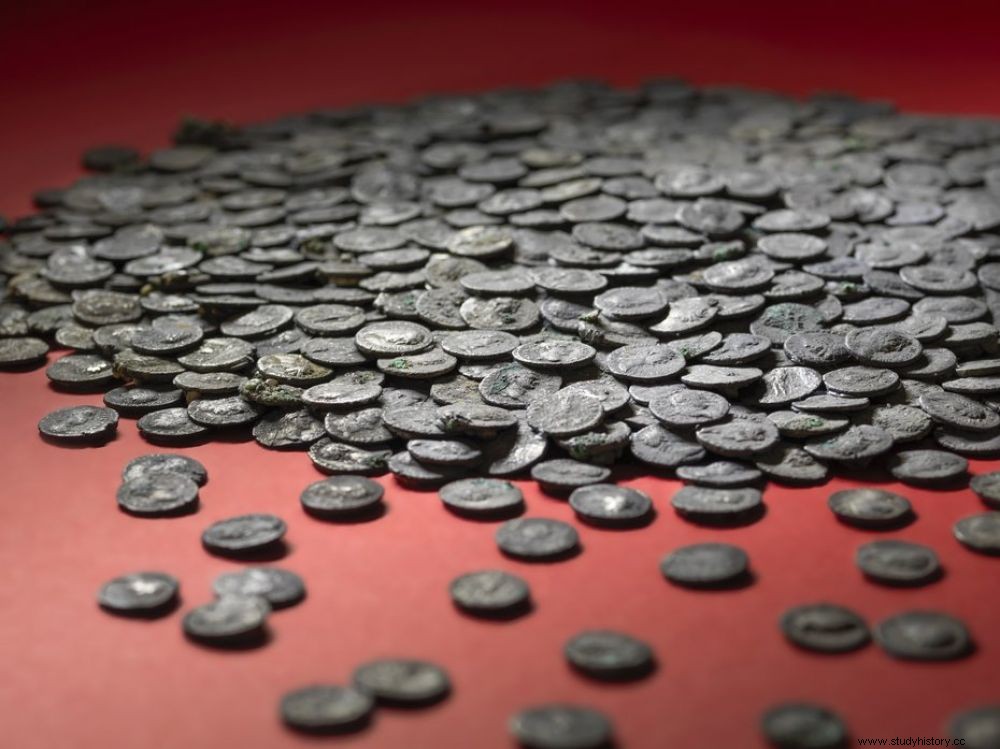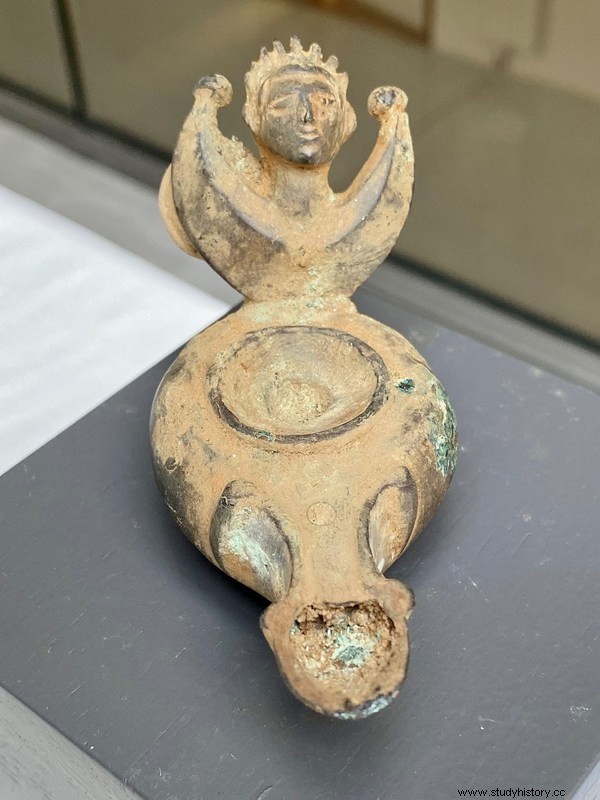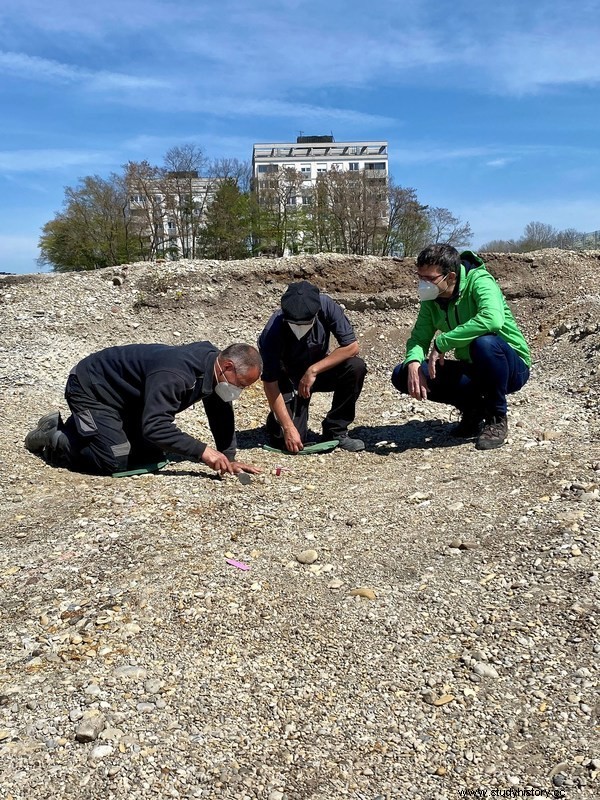Since June 2021, archaeologists in the city of Augsburg, Bavaria have had reason to rejoice:excavations carried out in an old river bed have yielded a quantity of objects and silver coins dating from the time. which are proof of the importance of the ancient capital of Rhaetia.

Archaeologists from the city of Augsburg have found 5,600 Roman silver denarii dating from the 1 st and 2 th centuries of our era.
At the end of October 2021, the Archeology Service of the city of Augsburg, in southern Germany, informed the public of an important discovery of silver coins dating from Roman times. This is the second time in a few months that, on the same site, preventive excavations have brought to light coins and multiple valuable objects which attest to the importance of the ancient capital of Rhaetia and the camp Roman which is at the origin of its foundation. This puts Augsburg in a good position to claim the title of oldest city in Bavaria.
Nearly 5,600 silver denarii dating from Roman times
The lot just found is the largest discovery of silver coins ever made in the Land of Bavaria, with nearly 5,600 denarii weighing in all around 15 kg. Dating from the 1st and 2nd centuries AD, they represent a wide range of Roman emperors, from Nero (54-68 AD) to Septimius Severus (soon after 200 AD). ). Most of these coins bear the effigy of the emperors Trajan (53-117), Hadrian (76-138), Antoninus Pius (86-161) and Marcus Aurelius (121-180), but there are also some rarer, like some adorned with the portrait of Didius Julianus (133-193), who only remained in power for two months before being assassinated. Although extremely rare and spectacular, this loot is not unequaled, recognized during a press conference the chief archaeologist of the city of Augsburg, Sebastian Gairhos:the treasure composed of 2,600 gold coins discovered at Truces in 1993 is much more valuable, since a gold coin (aureus ) was worth 25 silver denarii (denarii ) Romans.
400 kg of objects already unearthed
At the end of October 2021, the Archeology Service of the city of Augsburg, in southern Germany, informed the public of an important discovery of silver coins dating from Roman times. This is the second time in a few months that, on the same site, preventive excavations have brought to light coins and multiple valuable objects which attest to the importance of the ancient capital of Rhaetia and the camp Roman which is at the origin of its foundation. This puts Augsburg in a good position to claim the title of oldest city in Bavaria.
Nearly 5,600 silver denarii dating from Roman times
The lot just found is the largest discovery of silver coins ever made in the Land of Bavaria, with nearly 5,600 denarii weighing in all around 15 kg. Dating from the 1 st and 2 th centuries AD, they represent a wide range of Roman emperors, from Nero (54-68 AD) to Septimius Severus (soon after 200 AD). Most of these coins bear the effigy of the emperors Trajan (53-117), Hadrian (76-138), Antoninus Pius (86-161) and Marcus Aurelius (121-180), but there are also some rarer, like some adorned with the portrait of Didius Julianus (133-193), who only remained in power for two months before being assassinated. Although extremely rare and spectacular, this loot is not unequaled, recognized during a press conference the chief archaeologist of the city of Augsburg, Sebastian Gairhos:the treasure composed of 2,600 gold coins discovered at Truces in 1993 is much more valuable, since a gold coin (aureus ) was worth 25 silver denarii (denarii ) Romans.
400 kg of objects already unearthed
On the same site, some 200 meters away, the archaeologists of Augsburg had already discovered in June 2021 400 kg of objects of a quality which they guess is exceptional despite the corrosion. Found fragmented or even entirely preserved, these are weapons, tools, instruments, crockery, containers, but also jewelry, and more than 800 coins. A few of these artifacts had been presented during a press conference to highlight their value:bronze, ceramic and glass tableware from Italy and southern France; a bronze oil lamp, whose handle is made of a crescent moon surmounted by a bust of the Sun god; a silver brooch adorned with carved insects; the iron tire of a wagon wheel, and many amulets and bells previously attached to the harnesses of draft and saddle animals.

This bronze oil lamp is completely preserved . © Monika Harrer / Kunstsammlungen &Museen Augsburg
An old gravel pit scrutinized
All these objects, including denarii, were found after sifting through several thousand cubic meters of gravel from an old bed of the Wertach, one of the rivers that waters Augsburg. As Sebastian Gairhos explains, archaeologists assume that the treasure would have been buried there at the beginning of the 3 e century of our era and that the hiding place would have been carried away several centuries later by a flood of the Wertach; the pieces would then have dispersed in the gravel.
In 1913, when this site was exploited as a gravel pit, Roman discoveries had been brought to light, probably dating from the time following the conquest of the Pre-Alps (15 BC), but the context does not was not sufficiently documented to be able to draw meaningful conclusions. Then the construction of a factory prevented archaeologists from continuing excavations on this site now located in the district of Oberhausen, northwest of the city of Augsburg. It will therefore have been necessary to wait more than a century for the factory to be dismantled in order to be able to take them over and confirm the primordial value of the site. Current discoveries in fact make it possible to deduce that it housed a Roman camp.

The Oberhausen gravel pit corresponds to a former bed of the Wertach . © Monika Harrer / Kunstsammlungen &Museen Augsburg
The Roman camp and the city of Augusta Vindelicum
As indicated by the chronologically significant objects recently found - coins and imported pottery - the first foundations of the city of Augsburg are indeed on the site of Oberhausen and correspond to a Roman camp which would have been built there on the Wertach, in the newly conquered Alpine foothills, between 8 and 5 BC. AD, during the reign of Emperor Augustus (63 BC-14 AD). Two decades later (around 10 AD), this camp was destroyed by a flood, and replaced further south by a military camp of more than 10 hectares, with 3,000 soldiers. It stood on a rise between the Wertach and the Lech, in what is now the old town of Augsburg, near the garden of St. Stephen's Abbey. Around this vast camp, a colony of civilians grew rapidly during the 1 st century, which took the name of Augusta Vindelicum in honor of the emperor under whom the first Roman military base was established on the spot. The city then became the capital of the Roman province of Rhaetia, supplanting Cambodunum, present-day Kempten, in this function.
Augsburg is probably the oldest "Bavarian" city
These discoveries would therefore make it possible to prove that the first Roman military site in Bavaria is at the origin of the city of Augsburg, traditionally in competition with Kempten to claim the title of oldest city in the Land. But its first inhabitants had very diverse origins:officers and legionnaires came from Italy as well as Spain, North Africa and southern France; the horsemen came from Gaul and the Lower Rhine. On the other hand, the women present in the colony were undoubtedly from the foothills of the Alps and what today corresponds to northern Switzerland.
11 years salary of a legionnaire
Despite the first clarifications provided by the Augsburg archaeologists, questions still remain unanswered:to whom belonged the 5,600 pieces found in October and what this considerable sum of money corresponded to, knowing that it represents the equivalent of approximately eleven years salary of a legionnaire? It will be up to the Institute of Classical Archeology at the Eberhard Karl University in Tübingen to restore these coins and to deduce information about their potential former owners and the circumstances of their concealment. For the moment, Sebastian Gairhos presumes that it could be the cash of a wine or textile wholesaler who was doing business in the provincial capital. Their accumulation over a long period would otherwise be normal, as Roman coinage commonly circulated for 100, or even 200 years.
The city has planned to organize a temporary exhibition between December 17, 2021 and January 9, 2022 to admire these rich discoveries, a virtual visit could follow. Nothing definitive, however, because since the closure of the old Roman museum ten years ago, there is no longer any structure to highlight the Roman heritage of one of the oldest cities in Germany.
